A Better Business through a Great Place to Work for All
What was good enough Michael C. Bush, CEO & The Great Place to Work Research Team A Better Business through Great Places to Work to be “great” 10 or 20 years ago is not good enough now.
Our organization, Great Place to Work, knows.
Our mission is to build a better world by helping organizations become Great Places to Work For All. And for more than two decades, we have conducted one of the largest employee surveys in the world. In the United States, we are best known for producing the annual Fortune 100 Best Companies to Work For in America and other Best Workplaces lists. We also create similar lists in more than 50 countries across six continents, surveying as many as four million employees globally at more than 6,000 companies—firms that collectively employ roughly 10 million people.
Over time, this has amounted to a trove of data on what employees experience when their company is a Great Place to Work—and how leaders can build one. We have learned great workplaces are not created through a particular set of benefits, are not unique to a particular industry, or limited to public or private organizations.
Instead, universally, a Great Place to Work is one where employees trust the people they work for, have pride in the work they do, and enjoy the people they work with. Over the years, we have seen that these great workplace cultures are not only good for people, but good for business. Since our first list was published in 1998, the publicly traded Best Companies have nearly three times the stock returns compared to major indices.
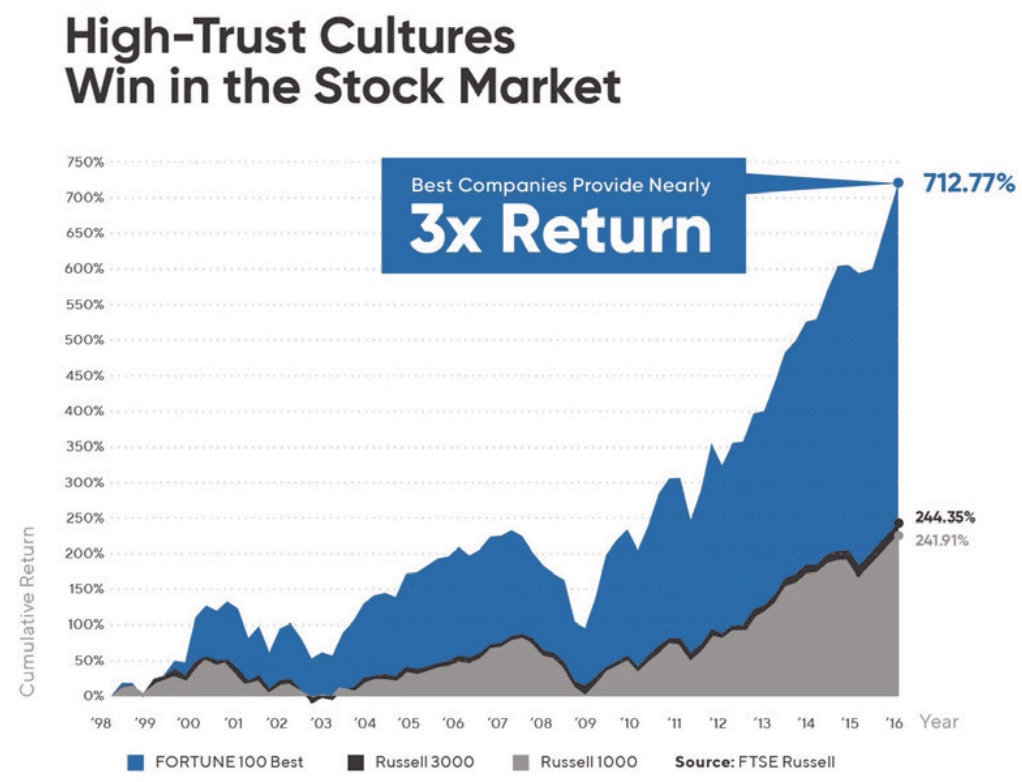
A New Frontier in Business
Our latest research shows, however, that this general formula isn’t good enough anymore. What it means to be a great workplace has evolved. We have entered a new era, a new frontier in business. Our economy has evolved through agrarian, industrial, and “knowledge” phases to the point where the essential qualities of human beings—things like passion, creativity, and a willingness to work together—are the most critical (1) In this “human economy,” every employee matters.
There is also new landscape facing organizations. Thanks to social and technology changes, what was good enough to be great 20 years ago doesn’t cut it today. Some business basics remain as true today as they have for decades. A successful company must have a sound business model, a smart strategy, and savvy financial management. But these fundamentals of a business school education are no longer sufficient. Changes happen faster, information moves rapidly with more transparency than ever before, and technology gives any customer or employee the power to be heard worldwide in an instant. These are some of the unique challenges of our times. And the best leaders are responding.
1. Dov Seidman, “From the Knowledge Economy to the Human Economy,” Harvard Business Review, November 12, 2014 (accessed October 10, 2017)
The new frontier in business is about responding to a landscape defined by speed and hyper transparency by developing every ounce of human potential. Companies must clear a higher bar in creating cultures that can tap into the potential of all employees—all ages, all genders, all races, all job levels.

The Best Companies to Work For in the United States have improved for employees over the past two decades, on average. But our data shows they are, to a great degree, still wasting human potential. They typically have pockets of people who do not feel fully alive at work and therefore are not contributing their best ideas or bringing the best of themselves to work. As a result, the company’s performance is sub-optimum.
If we’re going to call a company “great,” it’s got to be a place where everyone can bring the best of themselves to work each day. In other words, it’s got to be a Great Place to Work . . . For All.
A New Era, a New Definition of Greatness
With this new era has come a new, more comprehensive definition of what we consider a Great Place to Work. We haven’t lost our focus on the employee experience—we have simply widened our lens.
In the economy that’s taking shape, one in which more people expect to be included and expect more of companies, in which business agility is at a premium, and in which “hired hearts” are vital to success, the key to success is maximizing human potential.
Organizations are able to maximize human potential through leadership effectiveness, meaningful values, and a culture where all employees experience high levels of trust. When those pieces are in place, companies benefit from improved innovation and financial growth. In effect, the six elements work together to create a portrait of a Great Place to Work For All.
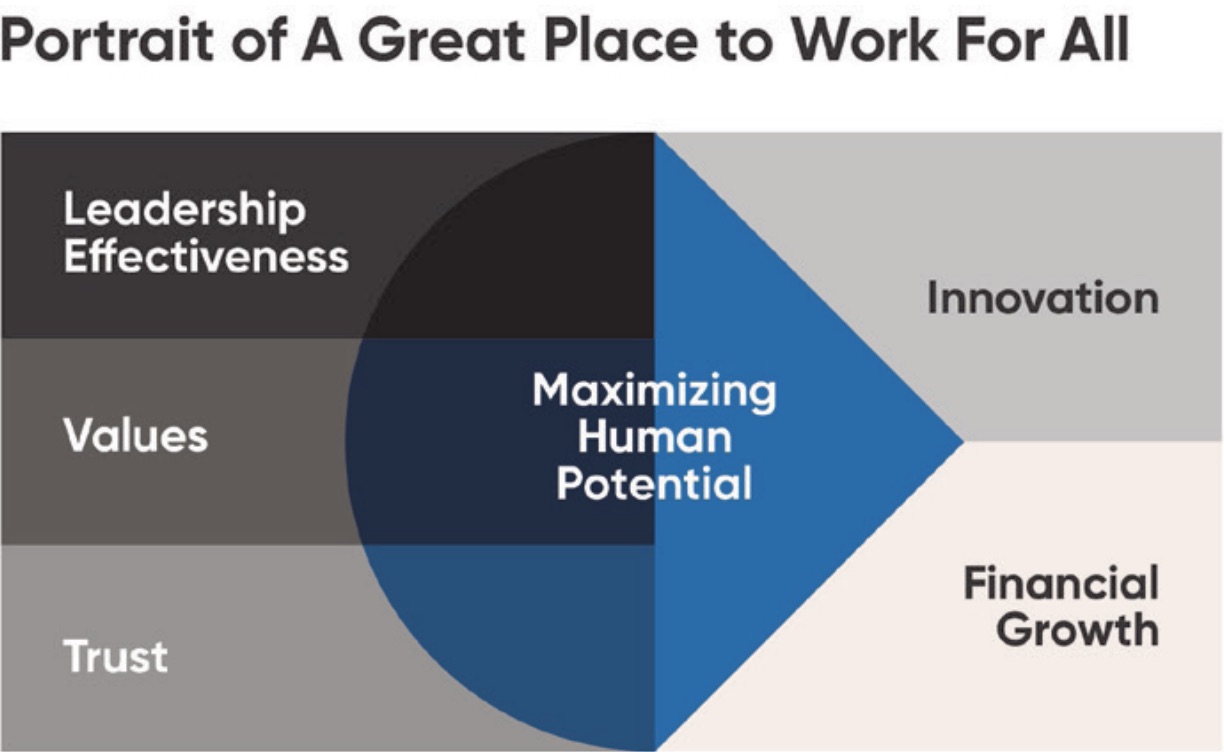
We’ve also raised the bar in our model and our methodology to reflect the new For All standard. We have updated our algorithm to assess how well companies create a consistently positive experience for all employees, no matter who they are or what they do for the organization. And we found that companies that rate most highly according to our new For All standard grow revenue three times faster than their less-inclusive rivals, and outperform the financial performance of the 100 Best Companies that were selected according to our former methodology (see graphs below).
In other words, while trust fuels business performance at great workplaces, For All accelerates it.
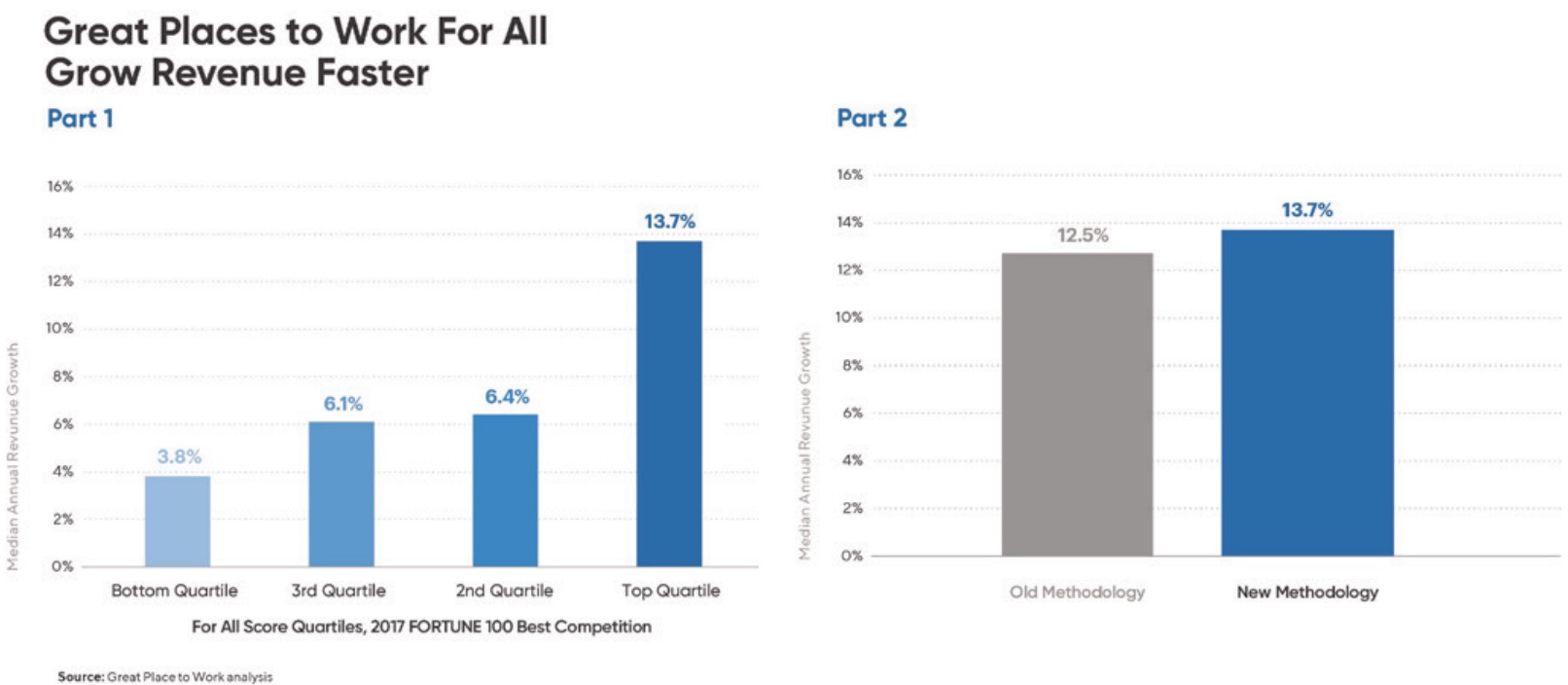
Central to a Great Place to Work For All: Maximizing Human Potential
Maximizing human potential is central to a Great Place to Work For All. It is pivotal to your success as a leader and a business. What do we mean by this phrase? We mean bringing out the best in your people—all of them. Enabling them to reach their potential as human beings; to be as creative, knowledgeable, and productive as possible. This means they are reaching heights they may not have thought possible in terms of projects they undertake, skills they develop, inspiration they feel.
Studies show that as few as 13% of the world’s workforce is actively engaged (2) However, work can be a place where people come alive, where they get in “the flow.” Where, in the framework of psychologist Abraham Maslow, they can “self-actualize.”
Organizations that maximize human potential are like sleek speedboats. Propelled by peoplepower engines firing on all cylinders, Great Places to Work For All zip ahead of their rivals, and they are winning. And leading them is thrilling.
2. Gallup has found that 87 percent of employees worldwide are not engaged at work, and that companies with highly engaged workforces outperform peers by 147 percent in earnings per share. See “The Engaged Workplace,” Gallup, 2017.
Leadership Effectiveness
Effective leadership means connecting with your and teams on a strategic and personal level, unlocking the full potential of your people and your organization. In practice, this means:
- Forging meaningful, respectful, caring relationships with employees in a fundamentally fair way
- Establishing high levels of interpersonal trust and successful collaboration within the executive team itself
- Creating and communicating a coherent strategy that cascades to every level of the organization
- An executive team that reflects the demographics of the organization and the wider community
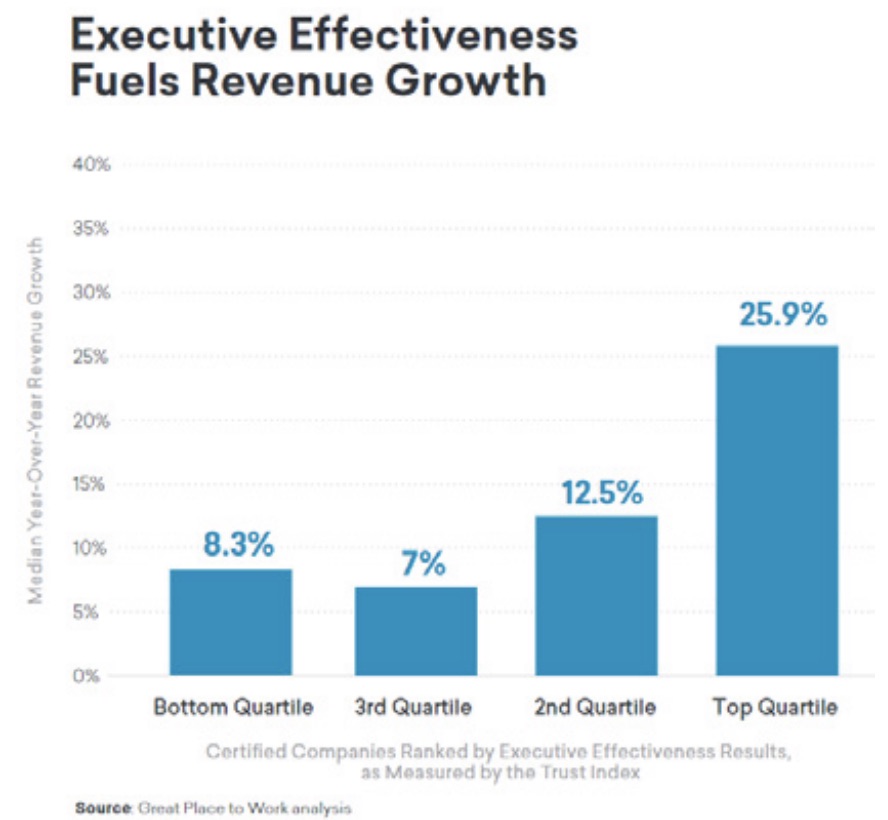
We’ve created an Executive Effectiveness Index that measures how employees view senior leaders on matters such as strategic clarity, even-handedness, and authenticity in their relationships. Companies with the highest scores on this index grew revenue three times faster than the companies with the lowest scores on the index (see graph).
In short, when executive teams perform well in these ways, the payoff is big.
Values
Values aren’t a new business topic. But what’s old is new again—or important in new ways when it comes to maximizing human potential and succeeding. When we talk about values at a Great Place to Work For All, we’re not talking about mere slogans on the wall or on the hiring page of your company website. We’re talking about principles that guide the day-to-day way everyone at your company works together. Smart companies today ensure those values and behaviors support their strategy.
Values also are what leaders use to make decisions that cannot be made using spreadsheets and data analysis alone. They are the bedrock principles that guide executives’ choices in complex, difficult matters—like hiring, firing, geographic expansions, doing more for customers, and mergers.
When companies live out strong values, employees buy in figuratively while customers buy in literally. Given shifts in the business landscape toward a more purpose-conscious public, heightened transparency into companies, and increased expectations that business leaders will lead on social issues, meaningful values are only growing more valuable.
A Foundation of Trust
The final key to maximizing human potential and creating a company built for success is a foundation of trust. Trust is what we discovered to be the cornerstone of great workplaces 30 years ago. And trust—specifically, a relationship of trust between employees and leadership— remains as important today as it was then. That’s because while business conditions have changed dramatically, people are still people. Trust is a universal requirement for positive interactions.
How do you build a high-trust culture? We believe the key elements of trust are credibility, respect, and fairness. Employees trust leaders when they see them as credible, as respectful, and as fair. Leaders must behave in a scrupulously fair way and demonstrate respect to everyone in the organization. They also must show themselves to be competent in running the business and consistent in living up to their word.
In talking about Great Places to Work For All, the “For All” component is about extending a great, high-trust climate and its benefits to everyone.
Innovation
When organizations maximize human potential through effective leadership, meaningful values, and a foundation of trust, good things happen. One of them is innovation.
At a time when new competitors can spring up suddenly across the globe, organizations today must innovate constantly—in terms of new products, new business lines, and internal systems to optimize efficiency and profitability.
But your grandfather’s approach to innovation won’t cut it. In recent years, it has become clear that listening to the “wisdom of the crowd” and seeking good ideas from everywhere leads to better results. What’s needed today is what might be called Innovation By All. That is, tapping the insights and ideas of employees from every level of the organization.
Our latest research points to the power of a For All culture on innovation and business results. Using our Trust Index Employee Survey, we created an index of what we call the Innovation Experience. It measures the extent to which all employees participate in activities related to innovation, experience leadership behaviors that foster experimentation, and feel inspired to move the organization forward.
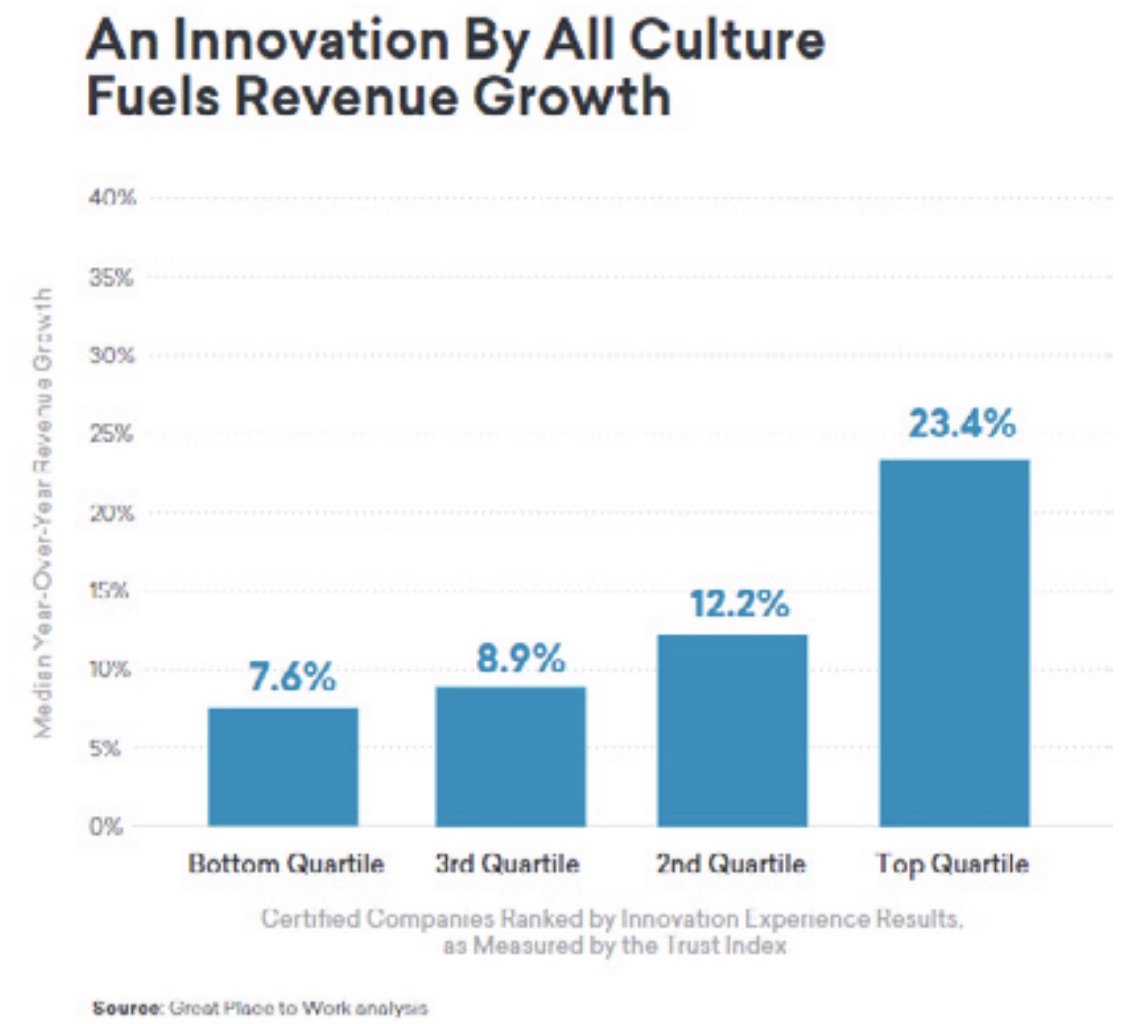
The results are striking. Companies in the top quartile on the Innovation Experience index had revenue growth more than three times the revenue growth of those in the bottom quartile. In other words, the organizations that best promote an Innovation By All culture leap ahead of the competition.
Financial Growth
Simply put, all of these factors together result in a healthier bottom line—including faster revenue growth. As noted above, our research shows that Great Places to Work For All grow their revenues faster than competitors.
There’s a secret weapon that many business executives fail to use: people power. People power means truly tapping the full potential of all your workers, regardless of who they are and what they do for the organization. When organizations create a consistently great work experience, they see revenue growth accelerate by a factor of more than three. That extra growth comes from people who are bringing their best to their jobs, thinking up new and better services in their spare time, and going out of their way—with a smile on their face—to serve your customers well.
In other words, through the power of your people you can make the revenue pie bigger.
Leading to a Great Place to Work For All
To understand how managers are leading their teams to a Great Place to Work For All, we dug into data from over 10,000 managers to identify five distinct leadership levels, which we’ve characterized into personas based on prominent themes. Together, they represent the For All Leadership Model. With each leadership level, a higher percentage of employees report they consistently experience a great workplace.
Our research shows that while For All Leaders surpass other leaders across all areas, the most dramatic differences are:
- Working with teams, including seeking out peoples’ input and involving them in decisions
- Recognizing people, from calling out their accomplishments to helping them get ahead in their careers
- Being someone people want to follow because they are confident that the leader is competent, honest, and reliable

Compared to employees with a Level 1 Leader, employees with a Level 5 For All Leader demonstrated:
- 353% higher productivity
- 300% greater agility
- 325% greater readiness to innovate
- 128% greater desire to stay
If companies are committed to building Great Places to Work For All, leaders need to have a clear understanding of how their teams experience them—for the sake of employees and for the business.
Great Leadership Redefined
We’ve presented compelling evidence that successful leadership is being redefined by the ability to create a Great Place to Work For All. But, why haven’t more leaders taken the steps to build a workplace that is consistently great for everyone, no matter who they are or what they do for the organization? Why haven’t more recognized and seized the power of maximizing everyone’s potential?
We hope that in 2030, all companies will achieve the new definition of greatness that we’ve presented here—thereby bringing out the best in everyone while lifting the organization, and the community around it, to new levels of prosperity.
We talk about our bold mission to build a better world through Great Places to Work For All as a rocket ship. On this ship, leaders find ways to connect with everyone, to develop the full human potential of all. And as a result, their businesses will flourish. Will you join the pioneers on the For All Rocket Ship? If you need a final bit of motivation before stepping on board, consider this: it’s going to be a fun ride. An adventure into what’s possible for human beings as they labor together. It’s going to be the journey of the twenty-first century.




